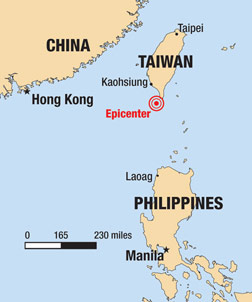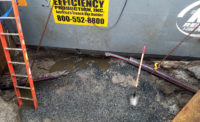Four big cable repair ships are converging on six submarine fiber optic cables damaged by an earthquake off Taiwan Dec. 26, trying to turn around the consequences of a “freak” seismic event that all but cut eastern Asia out of the Internet and sent a shiver through cyberspace as if someone had walked on its grave. Two ships were already at work by Jan. 4 and the others were enroute.
The initial quake—measured at 6.7 on the Richter scale by Taiwan’s Central Weather Bureau and 7.1 by scientist in the U.S.— with aftershocks, sequentially knocked out six of seven critical, deepwater telecommunications links off the southwest coast of the island.
 Nancy Soulliard |
The damage severely disrupted telecommunications and Internet service between North America and a vast swath of Asia, impacting not only Taiwan, but Korea, Japan, Hong Kong, China, Malaysia and Singapore as well. Voice traffic was restored fairly quickly but more data-intensive, international Internet services have been only gradually improved by rerouting traffic through satellites and other cables via Australia and Europe. Complete restoration may not be finished until early February.
The 140-m-long Tyco Durable is the first vessel on the scene.
A spokesman for Chunghwa said its cost for recovering and repairing the lines is expected to be $1,538,500. He says service is should be near normal by mid-January, but the actual timetable will depend on the damage found.
Also at work is the CS Wave Mercury, a 141.5-m-long cable maintenance ship with a cable capacity of 2,300 MT, out of Shanghai. It is the first of three ships dispatched by Chelmsford, Essex, U.K.-based Global Marine Systems and its Shanghai-based joint venture partner SBSS (SB Submarine Systems.) They are expected to be joined shortly by the Taiwan-based Fu Hai, a 105.8-m-long vessel with a cable capacity of 3,121 MT and the CS Cable Retriever, 131.3-m-long ship with a cable capacity of 2,475 MT that is based in the Philippines and reportedly stopping to pick up cable en route.
 Tyco Marine Tyco Durable
|
“The number of simultaneous cable failures was unprecedented,” says Global Marine’s Asia Director Ian Douglas, who added that the company was making “every effort” to get its, and its partners’ ships to the region to quickly start restoring network service to South East Asia. Douglas added that, fortunately, its joint venture partner SBSS and the Fu Hai are between projects, having just completed a six-month maintenance contract. The ship is “still available during January to continue carrying out these emergency repairs prior to commencing another commercial project,” he says
Global Marine reports that some of the cables are trapped under the seabed and others are tangled, making repairs exceptionally difficult. The ruptures are more than 3,300 m below sea level, well beyond the reach of the remotely operated vehicles commonly used in such projects. Instead, the vessels will secure and retrieve the cables with grapnels.
“This does highlight the vulnerability of our global communications network and the extent to which we rely on it,” says Gabriel Ruhan, CEO of Global Marine. “This was a significant earthquake, and we are glad we have vessels in the area which could so quickly be brought in to assist in the recovery and repair.”
 Global Marine Systems CS Wave Mercury
|
Global Marine, which has regional offices in the U.S. and Asia, is an independent marine engineering company specializing in submarine cable installation and maintenance. It operates the world’s largest fleet of cable ships and subsea vehicles and claims not only to have installed more undersea fiber-optic cables than any other operator, but also to repair and maintain 30% to 40% of the world’s subsea cable inventory. It also says it has installed more than half of the world’s buried fiber-optic cables as well.
|
Tyco spokeswoman Victoria Dillon says the three-year-old Tyco Durable, which arrived at the scene Dec. 30, is a highly maneuverable, “dynamically positioned” cable ship that uses advanced technology to pinpoint its location and control its operations. “When you get into the area it’s really the question of how you find the cable,” she says. The crew is also used to working in rough weather, she says, which is fortunate, as a vessel tracking website reported that as darkness fell on Jan. 4 winds were blasting at 32 knots and seas were 7 ft as the Tyco Durable worked to pick up the cables.
Cables are also usually more than simple point-to-point lines, Dillon adds. They are frequently installed as loops or rings with geographically separated landing points for redundancy. “They do plan for this type of thing,” she says. “When we design cable system we plan for scenarios to recover quickly.”
Deep Sea Fishing
 Global Marine Systems CS Cable Retriever
|
The cable operator starts the repair of a broken link by analyzing how a damaged cable responds to attempts to send data through it. The operator uses the data to try and plot the fault location on an electronic route chart. In cases where the water is less than 2 km deep, remote operated submarines are sent to the site to grab and lift the cable to the surface for repairs. In deeper waters, such as in this case, another technique is used. “The water is 3,300 meters deep, so we are having to use a grapnel on the sea floor—a hook on a long line, possibly two or three miles of line,” Dillon says.
Dillon says the ships will pull grapnels along the bottom while monitoring the tension on the line. Once it appears the cable has been snagged the ship will make a second confirming run and latch on. If the cable is completely severed, the end of it will be raised. The cables are laid with generous slack against just such eventualities, “It would be wonderful if they were exactly on the fault place,” Dillon adds.
 Global Marine Systems The Fu Hai
|
“They will pull it aboard the ship and jointers and engineers will conduct tests to see if the cable they have is fault-free back to the terminal station,” Dillon explains. “Then they will mark it with a buoy and drop back into the sea, reposition the ship to search for the other end and drag again.”
Once the vessel retrieves the other end of the cable, technicians test that side of the line and start splicing on new cable stock. The process involves working with microscopic precision to trim each hair-thin glass fiber in the cable’s bundle to a clean face and then laser- or arc-fuse a new section to get an optically clear joint. Then they feed the cable back into the sea as the ship returns to the buoy to retrieve, and ultimately splice the new section back to the fiber in the other end of the cable.
Freak accident
“The event in Taiwan is really, extremely unusual,” says Stephan Beckert, director of research at Telegeography, a Washington, D.C.-based research firm specializing in international telecommunications. “Cable outages happen all the time, but to have just about every cable into a country get snapped is unprecedented. In the 2004 Indonesian undersea quake there were no cables cut,” he says, adding, however, that the odds of so much damage happening from a single quake event are very small “This is just one of those freak events,” he says.
But it is serious, Beckert adds. “There are a lot of companies that have had some real issues with their corporate networks going down. All but one of the newer generation three-terabite/second cables into Taiwan was cut.” He also says that while the situation is not getting worse, repairing six cables at once strains the industry’s available capacity. “If you are looking to restore that much, it’s going to be a mess for a while to come,” he says.
Mainland China and Hong Kong were particularly impacted by slower data transmission speeds. On Jan. 4 Hong Kong’s Office of the Telecommunications Authority reported Internet access to overseas websites is still slow but capacity was back to about 80% of normal, thanks to rerouting arrangements.
The OTA says one damaged cable system should be back to normal operation by the mid-January, which “should significantly improve the situation.” The repair of the other damaged systems is expected to be completed progressively by the end of January or the beginning of February, “if the environment and the weather permit.”
The authority advises Hong Kong’s Internet users to avoid network congestion by minimizing non-essential visits to overseas web sites, uploading or downloading large files to or from those web sites, and other non-essential activities that demand large bandwidth over international connections, such as playing on-line games, video conferencing, other real-time multimedia services and P2P file sharing.
The vessel is based in Keelung, Taiwan, are carries a cable capacity of 5,465.5 metric tonnes. It is operated by Tyco Marine, Morristown, N.J., which has a maintenance contract with Chunghwa Telecom Co., Taiwan’s largest telephone company and one of the partners in the consortiums that operate the cables. In deep waters, where the cables do not need to be armored against fishing gear and dragging anchors, they are “about the size of a garden hose,” Dillon says.
 Related Links:
Related Links: 

Post a comment to this article
Report Abusive Comment